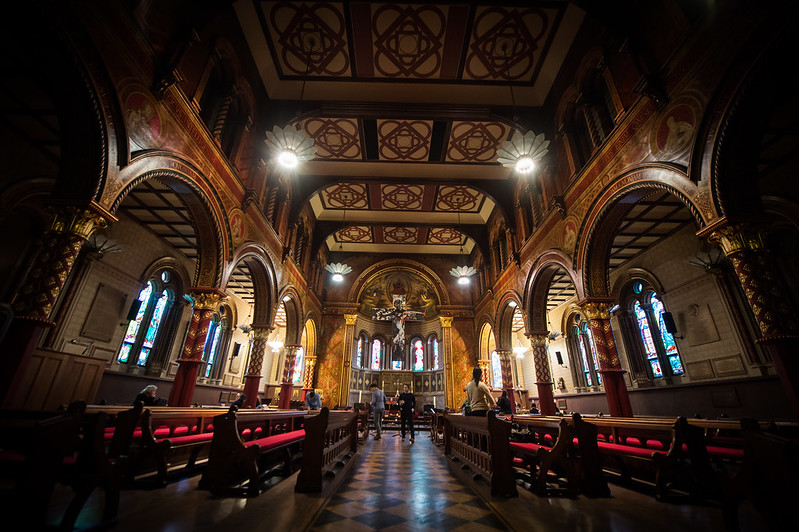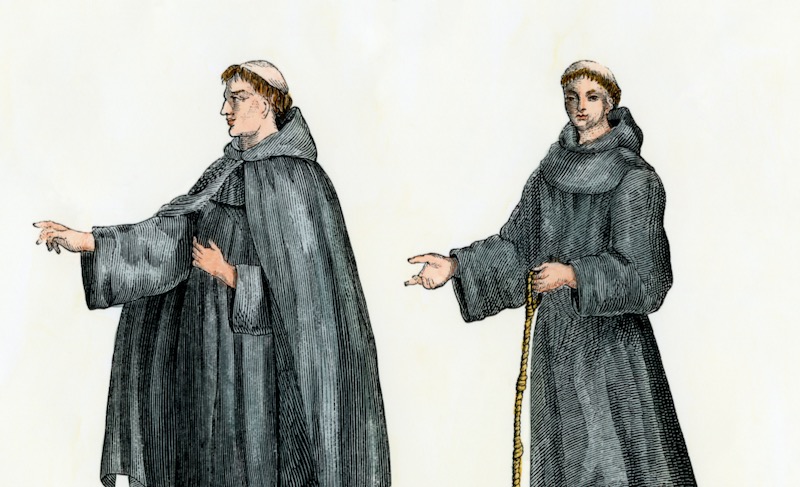In 664, churchmen and nobles gathered on a windswept headland above the North Sea to settle once and for all a pressing matter, which in the words of Bede “there was no small question about”. The decision reached at what’s known to history as the Synod of Whitby was so momentous that it echoed over the centuries, its resonance still faintly audible in our own secular times. I’m referring of course to the vexed question of the monastic tonsure or hairstyle.
Ok, I’m giving your leg the most gentle of tugs. The Synod, held at the renowned monastery of St Hilda, is of course most famous for its decision regarding the calculation of the date of Easter. But it’s clear that the correct form of the monastic tonsure was contested every bit as hotly as the true date of Easter between the Roman and Irish monastic missionaries who were seeking to evangelise the Northumbrians. And the decision regarding the tonsure – a highly visible signifier of monastic allegiance – equalled in significance that concerning the date of Easter in determining the religious and cultural destiny of the nascent English Church.
It’s time for some back story. Monks and their hairstyles had been a vexed question since the time of the “Desert Fathers”. These austere hermits retreated to the wildernesses of early fourth-century Egypt and Syria to escape the temptations of a sinful world. Their hair grew to be as wild as the wastes in which they lived and prayed. This shabbiness was too much for St Augustine (d. 430) and his inner puritan, who, riffing on the teachings of St Paul, complained, “Does not nature itself teach you, if a man has long hair, it is a shame unto him?”
By the seventh century, however, monks were no longer strangers to the razor. The issue was no longer whether monks should have their locks trimmed, but the style in which they should wear their hair. It’s clear from Bede (d. 735) that three types of monastic tonsure were then current, each associated with its own ecclesiastical tradition and geographical region.
Monks adherent to the Roman tradition shaved the top of their heads leaving only a narrow fringe around the back and brow of their heads. Irish monks shaved the front of their heads, ear to ear, while monks from the Greek East shaved the entire head.
The Roman style of tonsure is alluded to by the historian St Gregory of Tours (d. 594) and as early as 633 was called the “corona” or crown. It doesn’t take too much imagination to understand why Bede and other seventh-century Anglo-Saxon monastic authors associated it with the Crown of Thorns. Of equal antiquity was the Irish tonsure. Some scholars have argued it was a direct descendant of the razored hair-style sported by the ancient Druids – more on this later. As regards the Eastern tonsure, Bede tells how in 667 St Theodore (d. 690), a Syrian monk residing at a Greek monastery Rome, had to delay his departure for Canterbury, where he’d been appointed archbishop, for four months so his hair could grow sufficiently to be styled into the corona.
These differing styles acquired apostolic associations: the shaved crown and the fringe-like corona with St Peter and the bald head with St Paul. From early times, both distinctive patterns of alopecia were used to identify Saints Peter and Paul in art and remained a standard part of their iconography throughout the Middle Ages and beyond.
At the Synod of Whitby, King Oswiu of Northumbria ruled in favour of the Roman method for calculating the date of Easter because it was backed by the authority of St Peter. The Petrine associations of the Roman tonsure ensured that it likewise prevailed. “We who desire to be saved by Christ’s Passion, like Peter wear this sign of the Passion on the crown of the head, which is the highest part of the body,” wrote St Ceolfrid, Abbot of Monkwearmouth-Jarrow. The Irish tonsure, in contrast, was associated with Simon Magus and all his negative baggage, something which the supposed Druidic origins only amplified.
Mods and Rockers, Punks and Skinheads, Hipster quiff and Zoomer mullet. Immediately recognisable as a sign of identity and status, the cutting and styling of hair matters a lot in our modern consumer society. If anything, hairstyling was considered even more significant in the early medieval world. Then, the military elites were identified by – and extremely proud of – their flowing curled locks. Scalping or forcible tonsuring were considered not only humiliating but sufficient reason for a monarch to be deposed from his throne. The monastic tonsure was a very visible sign that monks had separated themselves from the violence and vanities of this warrior society and voluntarily embraced a life dedicated to Christ, humility and peace.
Monks (and priests) continued to be readily identified by their tonsure for the rest of the Middle Ages. The shaving of the head was a key ritual when a novice took his monastic vows thus separating himself from the world and becoming a full member of the community. Monastic “customaries” specified the regular intervals throughout the year at which monks were to have their heads and faces shaved. The tonsure survived the reforms of the Counter Reformation, enduring to 1972 when it was effectively abolished by papal decree.



 Loading ...
Loading ...
What do you think?
You can post as a subscriber user ...
User comments (0)